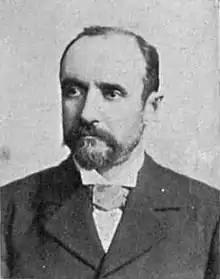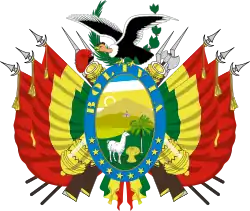José Manuel Pando | |
|---|---|
 | |
| 25th President of Bolivia | |
| In office 25 October 1899 – 14 August 1904 Junta: 12 April 1899 – 25 October 1899 | |
| Vice President | Lucio Pérez Velasco Aníbal Capriles Cabrera |
| Preceded by | Severo Fernández |
| Succeeded by | Ismael Montes |
| Personal details | |
| Born | 27 December 1849 Luribay, La Paz, Bolivia |
| Died | 17 June 1917 (aged 67) La Paz, Bolivia |
| Political party | Republican (1914–1917) Liberal (1884–1914) |
| Spouse | Carmen Guarachi |
| Parent(s) | Manuel Pando Petrona Solares |
| Education | Seminary School of La Paz |
| Signature | |
| Military service | |
| Allegiance | Bolivia |
| Branch/service | Bolivian Army |
| Years of service | 1871–1899 |
| Rank | General |
| Battles/wars | War of the Pacific Federal War Acre War |
José Manuel Inocencio Pando Solares (27 December 1849 – 17 June 1917) was a Bolivian soldier and explorer who served as the 25th President of Bolivia from 1899 to 1904. During his government, the Acre War (1899-1903) began, in which Bolivia clashed with Brazil.
Early life
Youth and studies
Pando was born in the town of Luribay on December 27, 1848. His parents were Manuel Pando and Petrona Solares. He studied at the Colegio Seminario de La Paz and continued his studies at the Universidad Mayor de San Andrés (UMSA) where he studied medicine, but only reached the sixth year before he abandoned it for a career in politics.[1]
At the age of twenty-three, Pando fought alongside the people of La Paz to overthrow the government of Mariano Melgarejo on January 15, 1871, after which he was incorporated into the Bolivian Army.[1][2]
Military career
After overthrowing Melgarejo, Bolivian President Agustín Morales appointed Pando as his personal aide-de-camp in 1871. Pando and Morales had an excellent relationship which allowed for the former's career in the army to be propelled to new heights. However, on November 27, 1872, when Morales was assassinated by his nephew and also aide-de-camp, Federico Lafaye, a heartbroken Pando resigned from the position of assistant to the President of Bolivia.[1][3]
In 1876, after Hilarión Daza's deposition of President Tomas Frías, Pando retired to private life in his Luribay hacienda. However, the outbreak of the War of the Pacific called him back to arms.[2][4]
During the War of the Pacific, Pando contributed to the Bolivian Army when, in the midst of the war, he took steps to bring artillery pieces from the United States, a task that General Daza had entrusted to him.[5] Pando fought in the Battle of Alto de la Alianza on May 26, 1880, where he was seriously wounded in the left arm and taken prisoner by the Chileans. He would be taken prisoner to Santiago in Chile. Upon his return to Bolivia, Pando led an artillery regiment until 1884.[1]
Explorer and adventurer
Pando was one of the great explorers of Bolivia during the 19th century. Pando's explorations provided a large deal of knowledge and helped in the integration of Northern Bolivia, then known as the National Territory of Colonies (then a largely unknown and obscure part of the country).[6][7] Today, this territory is composed of the departments of La Paz, Beni and Pando, the latter bears his last name in honor of his expeditions there. Several of his expeditions to the region took place around the Madidi, Madre de Dios, and Mamoré rivers, collective studies were made on the subject and published by the University of La Plata, in Argentina.[7] Furthermore, Pando's exploration greatly contributed to Bolivia's cartography, providing crucial knowledge about uncharted lands in the Amazon Rainforest.[8]
Political career
The Liberal Party
He entered as a member of the Liberal Party in 1884, a party of which he started leading after replacing General Eliodoro Camacho in 1894. He was head of the Liberal Party of Bolivia until the end of his presidency. Over the years, Pando became one of the greatest landowners of Bolivia, benefiting from the laws of 1874 and 1880.[2][4]
As head of the Liberal Party, Pando was a candidate for the presidency of the republic in the 1896 general elections, being defeated by the Conservative Party and its leader, Severo Fernández Alonso. That same year, he assumed the position of senator for the Department of Chuquisaca.[3]
Uprising against the Conservatives

Pando would be the leader of the Federalists when they rose up against the government in 1898, obtaining the support of the Aymaras of the country and of Colonel Pablo Zárate Willca, known as the "Fearsome Willka".[9] Turning several officers to his cause, including Octavio La Faye and Carlos Manuel de Villegas, Pando had large following in the army. Thus, the Bolivian Civil War of 1898-1899 began. After four months of fighting, he triumphed over the conservative forces of President Fernández in the Battle of the Segundo Crucero.[10] A Federal Government Board was created, made up of Pando, Serapio Reyes Ortiz and Macario Pinilla Vargas, which installed the seat of government in La Paz. The Board carried out some institutional reforms and public works, such as the construction of the government palace of La Paz. The Board was dissolved at the National Convention of 1899, when Pando was elected president.[1][2][3]
President of Bolivia
Administration

Pando was fifty years old when he assumed the Presidency. During his administration, the first Bolivian census of the 20th century was carried out in 1900. Moreover, it was discovered that there was a surplus in the trade balance, due to the rubber boom, ensuring that for the following decades the economy would be stable.[10]
Pando ordered the construction of roads going from the valleys to the plains, linking the distant settlements to the major urban centers of Bolivia in an attempt to connect the country and to improve infrastructure.[1] Another crucial event during Pando's presidency was the arrival of the first imported in Bolivia, brought to the country by adventurer Arthur Posnansky.
Internationally, Pando fought the so-called Acre War with Brazil. The region of Acre, located in the north and adjacent to the border with Brazil, had been invaded by Brazilian settlers and rubber tappers in the midst of a rubber boom.[6] The Bolivian government, attempting to assert its influence in that region, founded Puerto Alonso in 1899 and established taxes on rubber tappers. But the rubber tappers rebelled and started a secessionist movement called the First Revolution of Acre, which the Bolivian government was able to crush.[1] The second phase of this war, called the Second Acrean Revolution, occurred in 1902; this time, the Acreans asked to be annexed into Brazil.[11] The Bolivians suffered setbacks at the hands of the Acrean revolutionaries, so Pando personally marched to Acre at the head of an army.[2] This motivated the intervention of Brazil, which considered the area in dispute to be theirs and decided to send its army in support of the Acreans. This disparate situation forced the Bolivians to enter negotiations. Pando signed the Treaty of Petrópolis with Brazil by which Bolivia ceded territory in the north in exchange for significant financial compensation of two million pounds sterling.[11] Shortly after returning to La Paz, at the end of his term, Pando handed over power to Ismael Montes, who succeeded him as leader of the Liberal Party.
Later life and death
Pando was delegate in the territories of the North and Commissioner of Limits with Brazil.[1] He was appointed Brigadier General in the Army of Peru in 1911.[2][3] Having left the Liberal party, he broke with Ismael Montes and, in 1915, he became the founder of the Republican Party.
Retired, Pando was found dead in a ravine near El Kenko (now El Alto) on June 17, 1917. Many believed it was a political crime, perpetrated at the instigation of the Liberal Party. The murder was attributed to Alfredo Jáuregui, Juan Jáuregui, Néstor Villegas and Simón Choque. In 1927, Alfredo Jáuregui, the youngest of the brothers, was shot as a result of his alleged involvement in the crime against Pando.[12][13]
Modern investigations, however, maintain that Pando's death was due to natural causes, when he suffered a stroke while he was going from his farm in Catavi to the city of La Paz. According to this hypothesis, the members of the Jáuregui family, in whose hut Pando had stayed shortly before, upon discovering the body on the road, fearing being blamed for his death, threw the body into the ravine.[12]
See also
References
- 1 2 3 4 5 6 7 8 Paz, Sociedad Geográfica de La (1918). El mayor general Don José Manuel Pando: su vida y sus obras (in Spanish). Litografía e Imprenta "Moderna".
- 1 2 3 4 5 6 Mariaca, Ramón Salinas (1978). Vida y muerte de José Manuel Pando (in Spanish). Ultima Hora.
- 1 2 3 4 Crespo, Luis S. (1982). José Manuel Pando (in Spanish). Alenkar.
- 1 2 Mariaca, Ramón Salinas; Gámez, César Augusto Machicao (2010). Biografía conmemorativa del general José Manuel Pando: en homenaje a los 50 años del Colegio Secundario José Manuel Pando, 1960-2010 : Apolo, Franz Tamayo : La Paz, Bolivia (in Spanish). Estado Plurinacional de Bolivia, Ministerio de Culturas.
- ↑ State, United States Department of (1903). The Public Statutes at Large of the United States of America. U.S. Government Printing Office.
- 1 2 Pando, José Manuel (1895). Viaje á la regíon de la goma elastica (N.0. de Bolivia) (in Spanish). Museo.
- 1 2 Pando, José Manuel; Capriles, Anibal (1902). Colonisation et exploitations dans la République de Bolivie (in French). Imprimerie Lesigne.
- ↑ Mapa de la República de Boliv́ia, mandado organizar y publicar por el Presidente Constitucional General José Manuel Pando. Formado por Eduardo Indiaquez, Ingeniero de limites. Escala 1: 2,000,000. 1901.
- ↑ Mendieta, Pilar (2010). Entre la alianza y la confrontación: Pablo Zárate Willka y la rebelión indígena de 1899 en Bolivia (in Spanish). Plural editores. ISBN 978-99954-1-338-5.
- 1 2 Medinaceli, Ximena; Soux, María Luisa (2002). Tras las huellas del poder: una mirada histórica al problema de la conspiraciones en Bolivia (in Spanish). Plural editores. ISBN 978-99905-64-56-3.
- 1 2 Azcui, Benjamin (1925). Resumen histórico de la campañas del Acre, 1899-1903 (in Spanish). Tall. Gráf. de la Intendencia de Guerra.
- 1 2 Guzmán, Alcibíades. La muerte del mayor general José Manuel Pando: (expresidente de la República de Bolivia).. Estudio del proceso ante la opinión de la prensa (in Spanish). González y Medina Eds.
- ↑ Alcázar, Moisés (1980). Drama y comedia en el Congreso (in Spanish). Librería Editorial "Juventud,".
